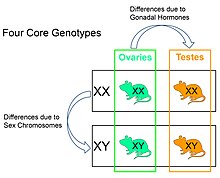17:
20:
The Four Core
Genotypes mouse model produces four types of offspring. Mice with ovaries (green) can have XX or XY sex chromosomes. Mice with testes (orange) can have XX or XY sex chromosomes. A difference in phenotype in mice with different sex chromosomes (XX vs. XY) shows a sex chromosome effect. A
51:. The comparison of XX and XY mice with the same type of gonad reveals sex differences in phenotypes that are caused by sex chromosome genes. The comparison of mice with different gonads but the same sex chromosomes reveals sex differences in phenotypes that are caused by gonadal hormones.
115:, and neural and behavioral processes. These findings imply that some sex chromosome genes may protect from disease, rationalizing the search for therapies that enhance such protective factors.
79:
3. Therefore the sex chromosomes no longer determine the type of gonad, so that XX and XY mice can have the same type of gonad and gonadal hormones.
299:
535:
134:"What does the "four core genotypes" mouse model tell us about sex differences in the brain and other tissues?"
68:
112:
104:
87:
The FCG model has been used to discover that the XX and XY animals respond differently in models of human
36:
that allow biomedical researchers to determine if a sex difference in phenotype is caused by effects of
60:
33:
21:
difference in phenotype in mice with different type of gonad shows the effects of gonadal hormones.
264:
64:
384:"Sex differences in obesity, lipid metabolism, and inflammation-A role for the sex chromosomes?"
511:
462:
413:
364:
315:
295:
256:
215:
163:
501:
493:
452:
444:
403:
395:
354:
346:
305:
287:
246:
205:
197:
153:
145:
506:
481:
457:
432:
408:
383:
359:
334:
310:
210:
185:
158:
133:
529:
268:
201:
540:
96:
448:
433:"Illuminating the Mechanisms Underlying Sex Differences in Cardiovascular Disease"
399:
291:
149:
40:
497:
100:
88:
76:
350:
186:"Four Core Genotypes and XY* mouse models: Update on impact on SABV research"
286:. Current Topics in Developmental Biology. Vol. 134. pp. 289–315.
16:
515:
466:
417:
368:
319:
260:
219:
167:
282:
Arnold, AP (2019). "Rethinking sex determination of non-gonadal tissues".
43:
or sex chromosome genes. The four genotypes include XX and XY mice with
251:
234:
92:
335:"The effect of sex on multiple sclerosis risk and disease progression"
108:
48:
233:
Turner, JMA; Mahadevaiah, SK; Arnold, AP; Lovell-Badge, R. (2020).
44:
37:
15:
72:
67:
at the
National Institute for Medical Research, London (now
71:). The model involves deleting the testis-determining gene
482:"X chromosome agents of sexual differentiation"
75:from the Y chromosome, and inserting Sry onto
8:
505:
456:
407:
358:
309:
250:
209:
157:
124:
32:) mice are laboratory mice produced by
382:Zore, T; Palafox, M; Reue, K (2018).
7:
179:
177:
14:
284:Sex Determination in Vertebrates
202:10.1016/j.neubiorev.2020.09.021
235:"Paul S. Burgoyne (1946-2020)"
1:
449:10.1161/CIRCRESAHA.122.320259
59:The FCG model was created by
400:10.1016/j.molmet.2018.04.003
132:Arnold, AP; Chen, X (2009).
431:Reue, K; Wiese, CB (2022).
292:10.1016/bs.ctdb.2019.01.003
150:10.1016/j.yfrne.2008.11.001
557:
498:10.1038/s41574-022-00697-0
339:Multiple Sclerosis Journal
47:, and XX and XY mice with
351:10.1177/1352458519892491
69:Francis Crick Institute
138:Front. Neuroendocrinol
105:cardiovascular disease
22:
333:Voskuhl, RR. (2020).
190:Neurosci Biobehav Rev
19:
536:Genetic engineering
480:Arnold, AP (2022).
184:Arnold, AP (2020).
113:Alzheimer’s disease
34:genetic engineering
26:Four Core Genotypes
486:Nat Rev Endocrinol
252:10.1242/dev.197467
65:Robin Lovell-Badge
23:
548:
520:
519:
509:
477:
471:
470:
460:
428:
422:
421:
411:
379:
373:
372:
362:
330:
324:
323:
313:
279:
273:
272:
254:
230:
224:
223:
213:
181:
172:
171:
161:
129:
556:
555:
551:
550:
549:
547:
546:
545:
526:
525:
524:
523:
479:
478:
474:
443:(12): 1747–62.
430:
429:
425:
381:
380:
376:
332:
331:
327:
302:
281:
280:
276:
232:
231:
227:
183:
182:
175:
131:
130:
126:
121:
85:
57:
12:
11:
5:
554:
552:
544:
543:
538:
528:
527:
522:
521:
492:(9): 574–583.
472:
423:
374:
325:
300:
274:
225:
173:
123:
122:
120:
117:
84:
81:
56:
53:
13:
10:
9:
6:
4:
3:
2:
553:
542:
539:
537:
534:
533:
531:
517:
513:
508:
503:
499:
495:
491:
487:
483:
476:
473:
468:
464:
459:
454:
450:
446:
442:
438:
434:
427:
424:
419:
415:
410:
405:
401:
397:
393:
389:
385:
378:
375:
370:
366:
361:
356:
352:
348:
345:(5): 554–60.
344:
340:
336:
329:
326:
321:
317:
312:
307:
303:
301:9780128115442
297:
293:
289:
285:
278:
275:
270:
266:
262:
258:
253:
248:
244:
240:
236:
229:
226:
221:
217:
212:
207:
203:
199:
195:
191:
187:
180:
178:
174:
169:
165:
160:
155:
151:
147:
143:
139:
135:
128:
125:
118:
116:
114:
110:
106:
102:
98:
94:
90:
82:
80:
78:
74:
70:
66:
62:
61:Paul Burgoyne
54:
52:
50:
46:
42:
39:
35:
31:
27:
18:
489:
485:
475:
440:
436:
426:
391:
387:
377:
342:
338:
328:
283:
277:
242:
238:
228:
193:
189:
141:
137:
127:
97:autoimmunity
95:, including
86:
83:Significance
58:
29:
25:
24:
239:Development
55:Development
530:Categories
144:(1): 1–9.
119:References
101:metabolism
89:physiology
77:chromosome
437:Circ. Res
394:: 35–44.
388:Mol Metab
269:225100609
516:35705742
467:35679362
418:29706320
369:31965884
320:30999979
261:33109617
220:32980399
168:19028515
41:hormones
507:9901281
458:9202078
409:6066740
360:7160019
311:7485614
211:7736196
196:: 1–8.
159:3282561
93:disease
45:ovaries
38:gonadal
514:
504:
465:
455:
416:
406:
367:
357:
318:
308:
298:
267:
259:
245:(20).
218:
208:
166:
156:
109:cancer
49:testes
265:S2CID
512:PMID
463:PMID
414:PMID
365:PMID
316:PMID
296:ISBN
257:PMID
216:PMID
164:PMID
91:and
63:and
541:Sex
502:PMC
494:doi
453:PMC
445:doi
441:130
404:PMC
396:doi
355:PMC
347:doi
306:PMC
288:doi
247:doi
243:147
206:PMC
198:doi
194:119
154:PMC
146:doi
73:Sry
30:FCG
532::
510:.
500:.
490:18
488:.
484:.
461:.
451:.
439:.
435:.
412:.
402:.
392:15
390:.
386:.
363:.
353:.
343:26
341:.
337:.
314:.
304:.
294:.
263:.
255:.
241:.
237:.
214:.
204:.
192:.
188:.
176:^
162:.
152:.
142:30
140:.
136:.
111:,
107:,
103:,
99:,
518:.
496::
469:.
447::
420:.
398::
371:.
349::
322:.
290::
271:.
249::
222:.
200::
170:.
148::
28:(
Text is available under the Creative Commons Attribution-ShareAlike License. Additional terms may apply.
